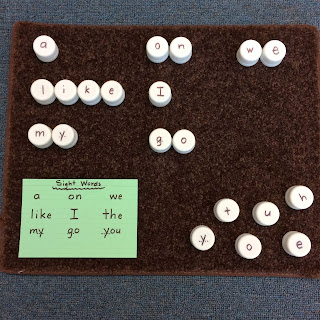A few weeks ago Emi asked about my approach to Literacy and teaching Phonics and Reading. This is a topic dear to me as I clearly remember learning to read in First Grade. It was magic!! We all sat on the floor in front of my teacher as she would read to us from a big Dick and Jane book. There was one with a red cover and one with a blue cover. She would read each page to us and discuss the pictures and have us repeat the words. The pictures were adorable and sweet. My brother and sister would have been Dick and Jane (I still love the name Jane) and I would have been the pesky little sister.
Even Spot looked like our cute dog. Along with Dick and Jane she taught us phonics to decode some words. Remember I already knew I was going to be a teacher, so I was watching carefully to learn what I did and didn't want to do when I was the one up there doing teaching. I read Dick and Jane books to my students so they can see how I learned to read. They are still so cute!
I teach my little ones with a variety of methods and materials. The basis of my literacy program consists of: teaching phonics for decoding and teaching Sight Words and teaching rules such as, "i before e except after c and when it sounds like a as in neighbor," and "silent e" etc.
We do a lot of writing - sometimes I give them a sentence starter using some of our Sight Words and sometimes they get do do Free Choice Journaling. e.g. "We like to ... "
I also have games and actvities for them to use to learn Sight Words. This I made using bottle caps and index cards and ziploc bags. This particular game is a favorite.
My phonics program stems from DISTAR (Direct Instruction System for Teaching Arithmetic and Reading) and Montessori. I did my Montessori training many years ago and am glad to see that so many methods and practices and materials now in use stem from Maria Montesori.
For sounding/blending/phonics I start by letting the kids know that we are going to start a new sound (I let them try to guess which one it is). I then show them the sound card and tell them the sound that this letter makes and say, "When I touch it you say it, keep on saying it as long as I touch it." (I have trained them how to do this - DISTAR) I put up the letter card along with pictures/words that start with that sound in the pocket chart.
I use the moveable alphabet for sounding out words - putting the little letter cards in the yellow and orange holder that is part of our Harcourt Brace Program - switching the letters to make words with the sounds that we've learned so far.
I also like the Phonemic Awareness component of the Harcourt Brace Program along with many of the books that come with it.
We make a Sound Chart with words that the kids tell me and I draw a little picture to remind them of what the word is - stick figures - and write their names under it. They love to read these word charts at Language Game time - when they Read the Room (Wright Group).
Speaking of Wright Group, I still love all my little Wright Group predictable readers. In fact I still like and use many of the lessons and methods I learned from my Wright Group trainings. I also use many of the Wright Group Big Books too for Guided Reading - they are great!
To sum it up, I teach kids how to read (and I've joyfully taught hundreds of kids to read) by using Phonics, Phonemic Awareness, Sight Words, Journaling, Poetry, Letter Writing, Book Making, Language Games, Reading the Room, Letter Cards, Moveable Alphabet, DISTAR, Montessori, Wright Group, Cooking (such as Making Gingerbread people for the soft g sound), Shared Reading (Read Alouds), Guided Reading , Predictable Readers, Phonetic Readers and other books and more. I have Reading Groups and I also do one on one reading with the kids. It is a fun and creative process with many years of practice behind it. Teaching children the basics of learning to read is really a fantastic part of teaching Kindergarten.











No comments:
Post a Comment